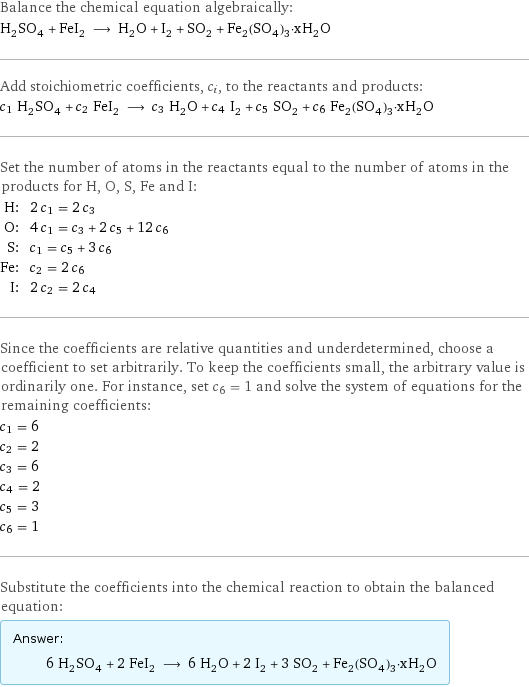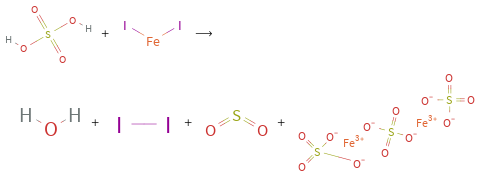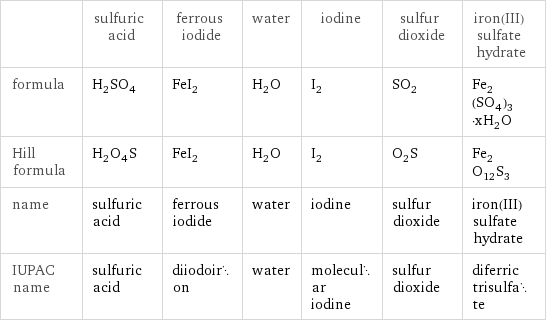Input interpretation

H_2SO_4 sulfuric acid + FeI_2 ferrous iodide ⟶ H_2O water + I_2 iodine + SO_2 sulfur dioxide + Fe_2(SO_4)_3·xH_2O iron(III) sulfate hydrate
Balanced equation

Balance the chemical equation algebraically: H_2SO_4 + FeI_2 ⟶ H_2O + I_2 + SO_2 + Fe_2(SO_4)_3·xH_2O Add stoichiometric coefficients, c_i, to the reactants and products: c_1 H_2SO_4 + c_2 FeI_2 ⟶ c_3 H_2O + c_4 I_2 + c_5 SO_2 + c_6 Fe_2(SO_4)_3·xH_2O Set the number of atoms in the reactants equal to the number of atoms in the products for H, O, S, Fe and I: H: | 2 c_1 = 2 c_3 O: | 4 c_1 = c_3 + 2 c_5 + 12 c_6 S: | c_1 = c_5 + 3 c_6 Fe: | c_2 = 2 c_6 I: | 2 c_2 = 2 c_4 Since the coefficients are relative quantities and underdetermined, choose a coefficient to set arbitrarily. To keep the coefficients small, the arbitrary value is ordinarily one. For instance, set c_6 = 1 and solve the system of equations for the remaining coefficients: c_1 = 6 c_2 = 2 c_3 = 6 c_4 = 2 c_5 = 3 c_6 = 1 Substitute the coefficients into the chemical reaction to obtain the balanced equation: Answer: | | 6 H_2SO_4 + 2 FeI_2 ⟶ 6 H_2O + 2 I_2 + 3 SO_2 + Fe_2(SO_4)_3·xH_2O
Structures

+ ⟶ + + +
Names

sulfuric acid + ferrous iodide ⟶ water + iodine + sulfur dioxide + iron(III) sulfate hydrate
Equilibrium constant
![K_c = ([H2O]^6 [I2]^2 [SO2]^3 [Fe2(SO4)3·xH2O])/([H2SO4]^6 [FeI2]^2)](../image_source/3da2b062c937e9a7d66e19978bb385ef.png)
K_c = ([H2O]^6 [I2]^2 [SO2]^3 [Fe2(SO4)3·xH2O])/([H2SO4]^6 [FeI2]^2)
Rate of reaction
![rate = -1/6 (Δ[H2SO4])/(Δt) = -1/2 (Δ[FeI2])/(Δt) = 1/6 (Δ[H2O])/(Δt) = 1/2 (Δ[I2])/(Δt) = 1/3 (Δ[SO2])/(Δt) = (Δ[Fe2(SO4)3·xH2O])/(Δt) (assuming constant volume and no accumulation of intermediates or side products)](../image_source/3ace972911de831a25d18a824a10500b.png)
rate = -1/6 (Δ[H2SO4])/(Δt) = -1/2 (Δ[FeI2])/(Δt) = 1/6 (Δ[H2O])/(Δt) = 1/2 (Δ[I2])/(Δt) = 1/3 (Δ[SO2])/(Δt) = (Δ[Fe2(SO4)3·xH2O])/(Δt) (assuming constant volume and no accumulation of intermediates or side products)
Chemical names and formulas

| sulfuric acid | ferrous iodide | water | iodine | sulfur dioxide | iron(III) sulfate hydrate formula | H_2SO_4 | FeI_2 | H_2O | I_2 | SO_2 | Fe_2(SO_4)_3·xH_2O Hill formula | H_2O_4S | FeI_2 | H_2O | I_2 | O_2S | Fe_2O_12S_3 name | sulfuric acid | ferrous iodide | water | iodine | sulfur dioxide | iron(III) sulfate hydrate IUPAC name | sulfuric acid | diiodoiron | water | molecular iodine | sulfur dioxide | diferric trisulfate